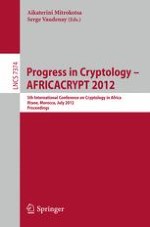This book constitutes the refereed proceedings of the 5th International Conference on the Theory and Application of Cryptographic Techniques in Africa, AFRICACRYPT 2011, held in Ifrane, Morocco, in July 2012. The 24 papers presented together with abstracts of 2 invited talks were carefully reviewed and selected from 56 submissions. They are organized in topical sections on signature schemes, stream ciphers, applications of information theory, block ciphers, network security protocols, public-key cryptography, cryptanalysis of hash functions, hash functions: design and implementation, algorithms for public-key cryptography, and cryptographic protocols.
